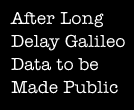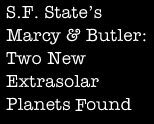

| "All the news that's fit to link." |
|
Posted: January 18, 1996 / Updated: February, 2 1996 |

F ollowing a long delay due to the government shutdown, the long-awaited first results from the Galileo Probe will be made public early next week. The news briefing is scheduled for 1 p.m. (EST) on Monday, January 22, at NASA's Ames Research Center in Mountain View, California. Related Sites BRIEFING SET TO ANNOUNCE EARLY GALILEO PROBE RESULTS What's new in Science: December Edition 
L ast month in "What's New," we ran an audio interview with San Francisco State astronomer Geoff Marcy, who helped confirm the existence of a planet outside our solar system. This month Marcy and colleague Paul Butler are again in the news, this time for detecting two more extrasolar planets. The two planets recently discovered were named 47 Ursa Major b and 70 Virginis b. 70 Virginis b is the first known extrasolar planet whose temperature is close to that of Earth's. The temperature is estimated to be 80 degree celsius, meaning that water (if present) would be liquid. Related Sites Sky and Telescope's Weekly News Bulletin January 19, 1996 What's new in Science: December Edition
|

After aiming the telescope at the region, from December 18 to December 28, scientists retrieved an image in which they found nearly 1,500 galaxies. Most of the galaxies are billions of light-years away and have a variety of unusual shapes and colors. "The variety of galaxies we see is amazing. In time, these Hubble data could turn out to be the double helix of galaxy formation. We are clearly seeing some of the galaxies as they were more than ten billion years ago, in the process of formation," said Robert Williams, Director
of the Space Telescope Science Institute in Baltimore, Maryland.
The "Deep Field" image was revealed earlier this week at a meeting of the American Astronomical Society. This image provides the deepest look yet into the universe.
Sky and Telescope's Weekly News Bulletin January 19, 1996
CNN Interactive:
Hubble eyes galaxies never seen before
We won't promise that we won't have an astronomy story next month. But we will promise this: there will be at least one story that doesn't have to do with astronomy in the next issue. See you next month.
|

|

|

|
| The Learning Studio | The Exploratorium |